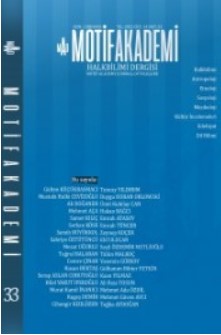PROF. DR. SEYFƏDDİN RZASOY’UN SON KİTABI ÜZERİNE
ON PROF. DR. SEYFƏDDİN RZASOY’S LAST BOOK
Author(s): Mehmet AçaSubject(s): Cultural history, Customs / Folklore, Review, Semantics, Theory of Literature
Published by: Motif Halk Oyunları Eğitim ve Öğretim Vakfı
Keywords: Qorqud Ata; The Book of Dede Qorqud; Kitabi-Türkman Lisani; Salur Kazan; Seyfəddin Rzasoy;
Summary/Abstract: The Book of Dede Qorqud and the independent narratives formed around the name of Qorqut Ata are among the subjects that folklorists frequently emphasize. The Book of Dede Qorqut is a subject that folklorists in Azerbaijan have seriously mastered. Studies on The Book of Dede Qorqut, which started in the 1920s in Azerbaijan, have continued with a continuous development until today. Studies on The Book of Dede Qorqut have gained a new dimension through a story about Salur Kazan killing the dragon with the narrations in a manuscript found in Turkmensahra in 2019. Azerbaijan National Academy of Sciences, Folklore Institute Mythology Department Director Prof. Dr. Seyfəddin Rzasoy has a special place among the names working on The Book of Dede Qorqut in Azerbaijan. Rzasoy, known for his works on mythology and The Book of Dede Qorqut, also focused on the aforementioned manuscript in Turkmensahra, which is described by some researchers as the third copy of The Book of Dede Qorqut. Rzasoy questioned the relevance of the manuscript to The Book of Dede Qorqut in his book titled "Kitabi-Türkman Lisani Oğuznaməsinin Transmediativ Strukturu ve Ritual-Mifoloji Semantikası” published in 2020. Rzasoy also meticulously studied the story with the "soylama"s in the manuscript. Rzasoy proved in his book that manuscript is not the third copy of The Book of Dede Qorqut. Rzasoy also proved that the story about Salur Kazan killing the dragon cannot be the 13th story of The Book of Dede Qorqut.
Journal: Motif Akademi Halkbilimi Dergisi
- Issue Year: 14/2021
- Issue No: 33
- Page Range: 410-418
- Page Count: 9
- Language: Turkish

